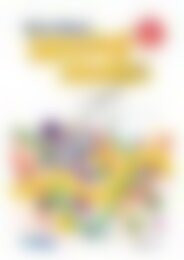PR-6171R Science A STEM Approach - Primary 2
Create successful ePaper yourself
Turn your PDF publications into a flip-book with our unique Google optimized e-Paper software.
Introduction<br />
What is <strong>STEM</strong>?<br />
<strong>STEM</strong> is the integration of science, technology,<br />
engineering and mathematics concepts using<br />
project-based and cooperative learning. Teachers<br />
have been integrating learning areas since the<br />
beginning of time, so although the idea behind<br />
<strong>STEM</strong> is not new, this series aims to make it easier<br />
for you to execute learning integration in the<br />
classroom.<br />
There has been much discussion about the importance of <strong>STEM</strong> skills, both in Ireland and around<br />
the world. The future workforce will require current pupils to be creative and critical thinkers who<br />
can collaborate and design solutions to problems. The skills utilised in <strong>STEM</strong> have never been more<br />
valued.<br />
<strong>STEM</strong> education aims to prepare pupils for the roles of the future with skills such as innovation,<br />
creativity, reasoning, problem-solving and technical science skills such as questioning, observing,<br />
systematic experimentation, and analysis and interpretation of data.<br />
Format of this Book<br />
This series focuses on delivering a comprehensive and contemporary science programme,<br />
culminating in a <strong>STEM</strong> project which applies the scientific knowledge acquired during the science<br />
lessons. The series incorporates the use of online resources, digital devices and tablet computer<br />
applications where appropriate, in order to enhance the use of information technology in the<br />
classroom.<br />
The Units<br />
This book is divided into four units: Living Things, Energy and Forces, Materials, and Earth and<br />
the Environment. At the start of each unit, keywords, a unit overview and a curriculum scope and<br />
sequence chart are provided, as shown below.<br />
Each unit contains six or seven lessons, a summative assessment of the science knowledge with<br />
teacher notes, and a <strong>STEM</strong> Project.<br />
Unit Overview<br />
Living Things<br />
CREATURE FEATURES IN<br />
living thing<br />
feature<br />
habitat<br />
plant<br />
animal<br />
DIFFERENT PLACES<br />
Keywords<br />
leaf<br />
stem<br />
flower<br />
seed<br />
root<br />
seeds<br />
fruit<br />
roots<br />
survive<br />
eat<br />
breathe<br />
move<br />
protection<br />
flower<br />
petal<br />
Prim-Ed Publishing – www.prim-ed.com 978-1-912760-15-2 1st <strong>Science</strong>:<br />
CLASS A <strong>STEM</strong> AP<strong>PR</strong>OACH 1<br />
stem<br />
leaf<br />
Unit Overview<br />
Living Things<br />
CREATURE FEATURES IN DIFFERENT PLACES<br />
<strong>Science</strong> Learning Concepts:<br />
• Observe, identify and explore a variety of living things from local and wider environments.<br />
• Recognise and describe the parts of some living things.<br />
• Appreciate that living things have essential needs for growth.<br />
Pages<br />
Lesson 1<br />
Pupils recall prior knowledge to establish what they 4–6<br />
Where are living things found<br />
know about what living things need, the features of living<br />
and what external features<br />
things and where they live.<br />
do they have to help them<br />
survive?<br />
Lesson 2<br />
Pupils explore four different habitats (pond, desert, 7–12<br />
Where do animals live and<br />
woodland and coast) and the animals that live there<br />
what external features do they<br />
through an interactive website. They learn about the<br />
have that help them survive?<br />
body parts of the animals that live there and how they<br />
help them survive.<br />
Lesson 3<br />
Pupils investigate animals that live at the beach and 13–18<br />
What animals live in the ocean<br />
underwater. The external features of fish, sharks and sea<br />
and what body parts do they<br />
turtles are explored and labelled, with the aid of research<br />
have that help them survive?<br />
via QR codes that link to videos.<br />
Lesson 4<br />
Pupils observe and investigate common footprints made 19–30<br />
What animals live in Irish<br />
by Irish woodland animals, including the rabbit, squirrel,<br />
woodlands and what body<br />
badger and fox. Pupils then focus on the rabbit and<br />
parts do they have that help<br />
create a fact minibook, labelling the rabbit’s external<br />
them survive?<br />
features and investigating how it uses its body parts to<br />
live in the woodland.<br />
Lesson 5<br />
Pupils explore creatures found in the garden by playing 31–34<br />
What insects live in the garden<br />
an interactive game. Pupils then explore by themselves<br />
and what body parts do they<br />
by photographing an insect from their own locality and<br />
have to help them survive?<br />
finding information about it. Pupils create a ‘creature fact<br />
file’ to present their information and include a labelled<br />
photograph.<br />
Lesson 6<br />
Pupils examine the common parts of a plant and use 35-38<br />
What are the parts of a plant<br />
an interactive game to label a plant and understand<br />
and what does each part do?<br />
the function of its features. Pupils then observe and<br />
investigate an actual plant and prepare an alien report<br />
explaining the parts of a plant and their functions.<br />
Lesson 7<br />
Pupils think about what plants belong in the desert and 39–43<br />
Why do plants from different<br />
the rainforest. They focus on leaves and the function of<br />
habitats look different?<br />
leaves to observe and investigate a cactus and a leaf from<br />
a rainforest plant and explain why the leaves are different.<br />
Summative Assessment Pupils draw an animal in its habitat and label the body 44–46<br />
parts, as well as draw a regular garden plant and its<br />
features and compare it to a desert or rainforest plant.<br />
<strong>STEM</strong> Project<br />
Pupils apply their knowledge of animal features and 47–54<br />
Alien Animals<br />
functions to create an alien animal using a website<br />
game. Pupils then design and make a 3-D display model<br />
suitable for the animal.<br />
2 <strong>Science</strong>: 1st<br />
978-1-912760-15-2 Prim-Ed Publishing – www.prim-ed.com<br />
A <strong>STEM</strong> AP<strong>PR</strong>OACH CLASS<br />
Living Things<br />
CREATURE FEATURES IN DIFFERENT PLACES<br />
Curriculum Scope and Sequence Chart<br />
Unit Overview<br />
Lesson 1 Strand: Living Things – Strand unit: Plants and animals<br />
• Observe, identify and explore a variety of living things in local habitats and environments.<br />
• Recognise and describe the parts of some living things.<br />
• Group and sort living things into sets according to certain characteristics.<br />
• Appreciate that living things have essential needs for growth.<br />
Lesson 2 Strand: Living Things – Strand unit: Plants and animals<br />
• Observe, identify and explore a variety of living things in local habitats and environments.<br />
• Develop some awareness of plants and animals from wider environments.<br />
• Recognise and describe the parts of some living things.<br />
• Group and sort living things into sets according to certain characteristics.<br />
Linkage: Strand: Environmental awareness and care – Strand unit: Caring for my locality<br />
• Observe and develop an awareness of living things in a range of habitats in local and wider environments.<br />
• Observe similarities and differences among plants and animals in different local habitats.<br />
Lesson 3 Strand: Living Things – Strand unit: Plants and animals<br />
• Observe, identify and explore a variety of living things in local habitats and environments.<br />
• Develop some awareness of plants and animals from wider environments.<br />
• Recognise and describe the parts of some living things.<br />
• Group and sort living things into sets according to certain characteristics.<br />
Lesson 4 Strand: Living Things – Strand unit: Plants and animals<br />
• Observe, identify and explore a variety of living things in local habitats and environments.<br />
• Develop some awareness of plants and animals from wider environments.<br />
• Recognise and describe the parts of some living things.<br />
• Group and sort living things into sets according to certain characteristics.<br />
Lesson 5 Strand: Living Things – Strand unit: Plants and animals<br />
• Observe, identify and explore a variety of living things in local habitats and environments.<br />
• Develop some awareness of plants and animals from wider environments.<br />
• Recognise and describe the parts of some living things.<br />
• Group and sort living things into sets according to certain characteristics.<br />
Lesson 6 Strand: Living Things – Strand unit: Plants and animals<br />
• Observe, identify and explore a variety of living things in local habitats and environments.<br />
• Develop some awareness of plants and animals from wider environments.<br />
• Recognise and describe the parts of some living things.<br />
• Recognise that trees are plants.<br />
• Group and sort living things into sets according to certain characteristics.<br />
Lesson 7 Strand: Living Things – Strand unit: Plants and animals<br />
• Develop some awareness of plants and animals from wider environments.<br />
• Recognise and describe the parts of some living things.<br />
• Recognise that trees are plants.<br />
• Appreciate that living things have essential needs for growth.<br />
• Investigate how plants respond to light.<br />
Prim-Ed Publishing – www.prim-ed.com 978-1-912760-15-2 1st <strong>Science</strong>:<br />
CLASS A <strong>STEM</strong> AP<strong>PR</strong>OACH 3<br />
Viewing sample<br />
iv<br />
Title Page Unit Overview Curriculum Scope and<br />
Sequence Chart<br />
978-1-912760-15-2 Prim-Ed Publishing – www.prim-ed.com<br />
<strong>Science</strong>:<br />
A <strong>STEM</strong> AP<strong>PR</strong>OACH<br />
1st<br />
CLASS


















